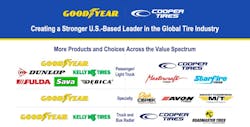Goodyear-Cooper Deal: Concentrated on Replacement Tires
As a combined company, Goodyear Tire & Rubber Co. and Cooper Tire & Rubber Co. represent 200 million tires sold, annual revenues of $17.5 billion and a business that would be 80% focused on the replacement tire business.
“It will solidify our place as one of the world’s top three tire manufacturers,” Goodyear Chairman, CEO and President Rich Kramer told investors on Feb. 22, the day the two Ohio-based tire companies announced their plans to merge.
Among the advantages of Goodyear’s acquisition of Cooper is combining their market presence in the U.S. and in China, which Kramer notes are “the two largest tire markets in the world accounting for approximately one-third of global industry volume.”
In the U.S., the combined companies sold 64 million consumer replacement tires in 2019 (including private labels), and another 10 million in the original equipment U.S. channel.
In China in 2019, Goodyear and Cooper combined for 5 million consumer replacement units, and 9 million consumer OE tires.
Worldwide, the two companies have 38 tire manufacturing facilities — 30 for Goodyear and eight for Cooper, and Kramer said the product portfolio with multiple brands in both top and mid-level tiers is an important part of the equation.
“Given industry trends in the U.S. market we believe there are significant advantages to offering a more comprehensive portfolio. This robust suite of brands will allow us to have an unmatched product offering across the entire value spectrum assuring we can meet the needs of all customers and consumers,” Kramer said.
Brad Hughes, CEO and President of Cooper, agreed. “We’ll also have the flexibility and world class talent required to invest and innovate and to continue to meet the needs of an evolving and competitive industry landscape.”
Just as Goodyear expects to see benefits of scale in manufacturing, it forecasts similar benefits in adding Cooper’s products to the Goodyear tire distribution network. Yes, that includes TireHub, as well as Goodyear-owned retail outlets and Goodyear’s e-commerce platform and mobile tire installation business.
Kramer said, “We also see value and further opportunities to expand capacity to Cooper’s low-cost facilities over time, offering attractive capital efficiency and strengthening product supply in the future.”
In all, the companies have identified $165 million in savings from synergies to come within two years of the deal’s closing, though Darren Wells, executive vice president and chief financial officer at Goodyear, stressed those savings do not include consolidations in manufacturing.
“There are no manufacturing savings embedded in the $165 million,” he said.
The bulk of those savings would come from duplicate SAG expenses, corporate overhead and research and development spending, with additional savings from warehouse consolidation and freight optimization.
There are additional financial advantages on the table, too — an estimated $450 million in tax savings and one-time capital savings of $250 million.
